18 May: Paracas to Nazca
We were dropped off at the "Cruz del Sur" bus station in the
hotel's
buggy. We
counted on
the fact
that we
would be
served
lunch,
as
on our
first bus
journey,
as we had
no money
left to
buy
sandwiches!
We were in
for a bad
surprise
however: no
lunch was
served
on
our bus
journey
from 10:30
to 14:30,
but on the
previous
trip
starting
at 14:00
lunch was
served! We
were able
however to
scrounge
a
few
left-over
breakfast
trays from
the
morning's
service.
At l
east
the
kids
didn't
starve to
death!
A taxi driver jumped on us when we arrived in Nazca to drive us
to our
hotel (we
managed to
stop at an
ATM on the
way to
withdraw
some
much
needed
cash!). The
driver
then
proposed
to take us
to
the
airport to
reserve a
flight
over the
Nazca
lines: a
proposition
we
accepted
as
it matched
our plans.
As
everybody
knows,
Nazca
is
famous,
world-wide,
for its
amazing
geoglyphs
drawn in
the
desert
approximately
2000 years
ago. Nobody
knows with
certitude
why
these giant
geoglyphs,
representing
animals,
humans
and
geometric
shapes,
were
created especially
as they're
only
visible
from the
skies.
After much negotiation concerning the price for the kid's
flight
tickets,
we
purchased
flight
tickets
for the
next
morning
and
decided
to
spend
the
rest
of
the
afternoon
in the
Antonino
museum to
learn
more
about
the
Nazca
civilisation. In
addition
to the
mysterious
Nazca
lines,
this
civilisation
mummified
their dead
in
desert
tombs and
deformed
babies'
skulls as
a status
symbol
(royals
and
nobles
were
recognised
by their
elongated
skull).
We dined in a friendly and very reasonable restaurant
(the girls
spent most
of the
evening
playing
with the
owners two
kittens...)
and then
tried to
sleep in
our hotel
room which
was situated
on one of
the
noisiest
crossroads
in town:
the
concerto
of
horns was
deafening
and the
numerous
CD sellers
in
the
streets
below were
competing
with their
loudspeakers
to promote
their
merchandise.
In
addition
we had the
unpleasant
impression
that we'd
been
ripped off
by the
ticket
sellers
who were
probably
not, as
stated, the
flight
company's
employees,
but
intermediates
charging a
hefty
commission...
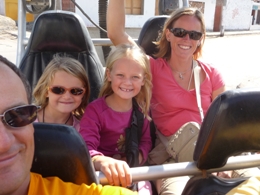 |
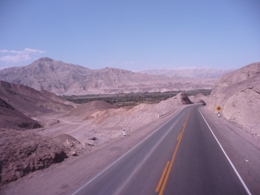 |
| Buggy ride to
the
bus
terminal |
The road to
Nazca |
19 May: Nazca
We were picked up from our hotel at 6:30am for our flight over
the Nazca
lines. We
did a 35
minute
flight
over
the fascinating
drawings
in the
desert:
a
whale, an
astronaut, a
dog, a
monkey, a
condor, a
spider, a
humming
bird, a
tree, a
strange
being with
hands, a
parrot and
a baby
condor.
The
drawings measure
between
100
and
300
metres
and
are
only
visible
from the
sky. Why
the Nazca
civilisation
created
these
lines 2000
years
still
remains a
mystery,
but
in our
opinion
the most
plausible
theory is that
they
were
used
as sacred
pathways for
rituals.
The 4-seater Cessna
plane flew
around the
lines at
angles
approaching
45º, which
was
excellent
for
viewing
the lines
but not
so
good
for
Sophie.
She didn't
manage
to land
without
being
suffering
from air
sickness...
After breakfast at the hotel we headed to the streets of Nazca to
book an
excursion
in the
afternoon
to The
Chauchilla
cemetery.
After
visiting
5
agents
we
managed
to
book a
trip for a
reasonable
price;
quotes
varied
from 120
Sol per
person to
100 Sol
for the
four
of
us!!! The number
rip-off
agents in
Peru has
unfortunately
tarnished our
impression
of what
could be a
superb
tourist
destination.
The Chauchilla cemetery was a bit morbid: it was full of
excavated
tombs
containing
500 year
old
mummies
and bones.
So many
of
the old
tombs
had
been
pillaged
that old
bones and
remnants
of
the
deceased's
fabrics
littered
the
surrounding
landscape...
We then
visited
a
potter's
workshop and
saw a
demonstration
of how to
make
replicas
of old Na
zca
potteries.
We spent the evening on the first floor terrace of a nice
restaurant,
doing the
girls'
homework
and
dining, before
the
night
bus'
10pm
departure
to
Arequipa.
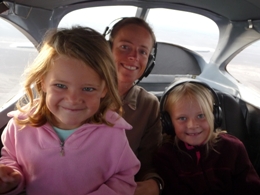 |
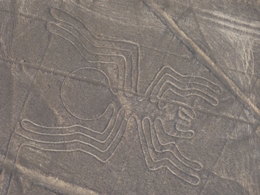 |
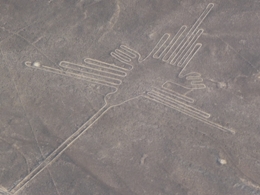 |
| Flying in the
Cessna
over
the
Nazca
lines |
The Spider |
The
Hummingbird |
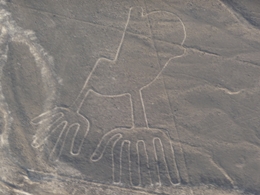 |
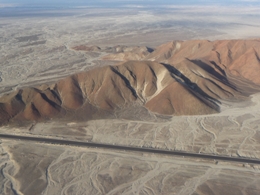 |
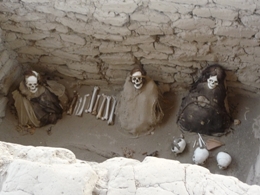 |
| The Hands |
A view of the
Nazca
plain |
Mummies in a
tomb
at
Chauchilla
cemetery |
20 May: Arequipa
We arrived with the night bus at 7am in Arequipa. Jenny and the
girls
slept surprising well
-
the
seats
recline a
lot -
but
François
arrived a
bit
tired...
Fortunately
we were
able to
settle
into our
hotel room
upon
arrival.
We
showered,
changed and
went down
for
breakfast.
Then we
hit the
city of
Arequipa.
We walked
the
kilometre
from the
hotel to
la Plaza
de
Armes,
in
the
city
centre.
The city's
architecture
is
beautiful:
lots of
Spanish
colonial
white
stone
buildings
with
lovely
carvings.
We
visited
the
cathedral
which is
peculiar
as the
facade
actually
covers
the
side
of
the
building
not the
extremity.
We also
visited
the church
called La
Compañaia
and its
superbly
restored cloisters.
Then we
went to
see the
Ice
Maiden: a
frozen
body of an
Inca girl
found
on
the
slopes
of
the
volcano
Ampato.
The girl
aged
between
12
and 13
years
old,
had
to
walk up
to
the
volcano's
crater at
6380m (not
a
mean
feat)
and
then was
sacrificed
to the
mountain
gods by
Inca
priests
some 500
years ago.
Pretty
morbid...
The museum
is very
interesting
but
unfortunately
the Ice
Maiden,
baptised
Juanita,
is
conserved
in a
freezer
compartment
in the
darkness,
so one can
only just
make out
her
face.
In the
afternoon
we spent a
couple of
hours
walking
around the
magnificent
Santa
Catalina
Monastery:
its like
a town
within a
town!
The
monastery
houses
less than
30 nuns
today, but
in its hay
day it
housed
450, plus
servants. It's
very
picturesque
with its
dark
orange
and
bright
blue
walls,
narrow
streets,
living
apartments,
cloisters,
fountains,
religious
paintings and
artefacts
from the
nuns
everyday
lives.
We then took a taxi up to Yarrahuara to see the white stone
church and
lovely
viewpoint
over the
Misti
volcano
and
surrounding
mountains.
We sipped
a glass of
Peruvian
white wine
(not bad
at
all!)
on
the
terrace of
a nice
wine bar
watching
with a
beautiful
backdrop
of the
Misti
volcano at
sunset. Despite
the air
pollution,
we were
surprised
how
beautiful
the city
of
Arequipa
was and we
thoroughly
enjoyed
our
day's
visit.
The girls were both exhausted this evening so we tucked them up
into bed
early. Tomorrow
we head up
to
Chivay and
the
Colca
Canyon on
a 2-day
excursion.
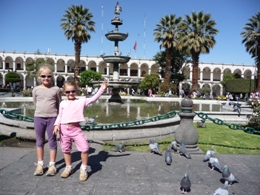 |
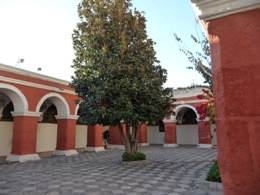 |
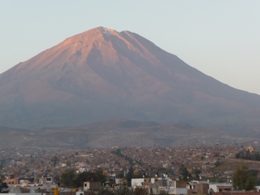 |
| Plaza de Armes
in
Arequipa |
A cloister in
Santa
Catalina
Monastery |
The Misti
volcano |
21 May: Arequipa to Chivay
We had to set the alarm at 7am this morning in preparation
for a two
day
excursion to
Chivay
and the
Colca
Valley. A
mini-bus
came to
pick us up
from the
hotel
after
breakfast
and off
we
set for
a
long
drive
to
Chivay,
accompanied
by a
Peruvian
guide
and
4
other
tourists
(2
Americans
with
Peruvian
roots and
2
English).
The first
stop was a
mere 10
minutes
after
departure
to
stock
up
on coca
products
to
help prevent
altitude
sickness: Chivay
is at 3600
metres
above sea
level and
the
road crosses
a pass
at 4900
metres
(higher
than Mont
Blanc).
We
bought
coca
leaves to
chew, coca
sweets and
a coca
fizzy
drink
and
crossed
our
fingers
that
everybody
would be
OK. On the
way
up we
stopped
off several
times to
admire the
scenery
and
native
animals.
We saw one
of Peru's
emblems,
the
Vicunas (a
sort
of
orange
and
white
lama),
as
well as
lamas,
alpacas
and long
tailed
rabbits.
At the
highest
point, at
4900m,
we braced
the cold
air
and
altitude
and
admired
the
stunning
views of
the
surrounding
mountains
and
volcanoes.
Local
women in
tradition
dress were
also
bracing
the cold
and
selling an
array of
alpaca
knitwear
and
souvenirs.
We bought
Gaelle an
alpaca
poncho
before
continuing
our
journey
to
Chivay.
We
arrived
for lunch
at 13:30
in Chivay,
after
a lovely
scenic descent
from the
pass.
After checking into our hotel we wandered around the local market
and bought
a second
poncho,
for Sophie
this time!
Next on
our agenda
was a dip
in the
nearby hot
sulphur
springs.
We spent
nearly an
hour
and a
half
in
the
lovely
warm
waters (40
degrees) of
an outdoor
pool, with
a
beautiful
mountain
backdrop.
We were all pretty tired out that evening so we decided to eat
quickly in
the
hotel's
restaurant
before
settling
down for
the
night.
Our
alarm
was
set
for
5am
for
our
meeting
with the
condors in
the Colca
Valley.
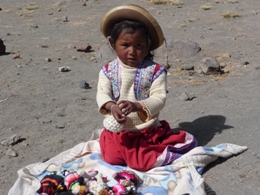 |
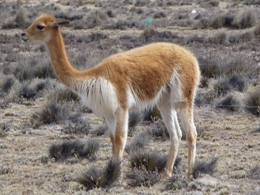 |
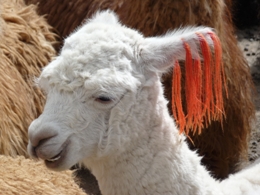 |
| A Peruvian
girl
in
traditional
dress |
A Vicunas: a
breed
of
South
American
camal |
An alpaca with
earings! |
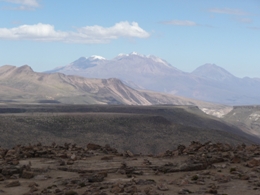 |
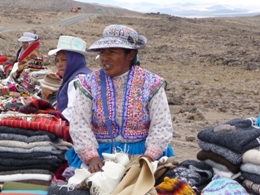 |
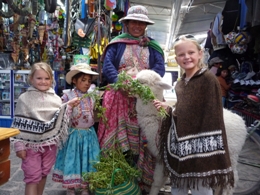 |
| The volcanoes
from
the
pass |
Peruvian
ladies
selling
their
wares
at
4900 metres! |
A meeting with
a
Alpaca
in
the
local
market at Chivay |
21 May: Colca Valley
We left the hotel at 6am in direction of the Colca Valley.
We had a
30 minute
stop at
Yanque to
see the
church and
local
people
selling
their
wares. On
the
village
square
there were
young
children
dancing
the
traditional
Wititi
dance and
eagles
and
lamas
to
admire.
Both
Gaelle and
Sophie
were
photographed
with an
eagle on
their
arms
and
as it
was
really
chilly
we
bought
knitted
gloves for
the girls.
We were
dressed in
all our
warm
clothes: a
T-shirt
and
jeans,
plus a
fleece
jumper, a
fleece
jacket and
a goretex
jacket so
hopefuly
it won't
get much
colder
than
this!
We spotted tw condors flying around the viewing area as we
approcahed
in the
minibus.
Excited we
made our
way to sit
down at
the
condor
viewing
platform.
Within the
first hour
we saw a
few
condors
fly past,
but
nothing
really
spectacular.
Then as we
changed
viewing
area, the
sun came
out and
the
thermal
breezes
picked up.
We
were
rewarded
for our
patience
by 20-30
condors
that
glided up
with
the
thermals
to within
only
metres of
our
vantage
point. It
was
spectacular
to see
these huge
and
graceful
birds,
with
windspans
up
to 3.2
metres,
gliding
below, in
front
of and
above
us.
On the way back down the Colca Valley we stopped to admire the
Inca
terraces
and
irrigation
channels
that were
built some
1000
years
ago
and
some
Inca
tombs
on
the
face
of
the mountain.
At the end of the afternoon we arrived back in Arequipa. In the
evening we
walked
into
the
city
and
ate
dinner in
a pizza
restaurant.
We had a
nice
break
whilst the
kids had a
whale of a
time
playing with
local
children
on an
indoor
playground
in the
restaurant.
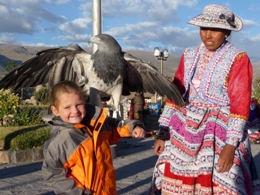 |
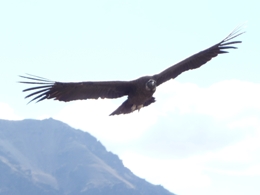 |
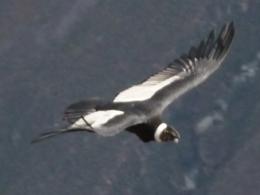 |
| Sophie holding
an
eagle
at
Yanque |
A condor
gliding
in
the
Colca
Canyon |
An adult
condor |

BACK
| 
